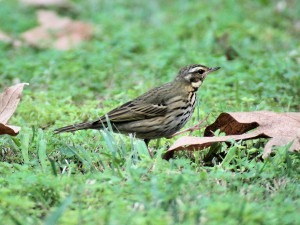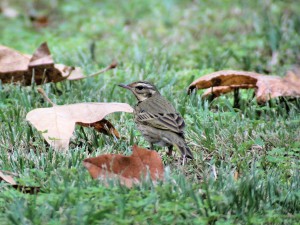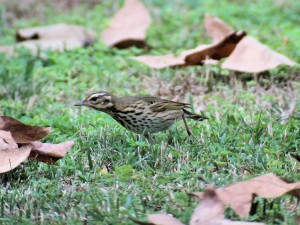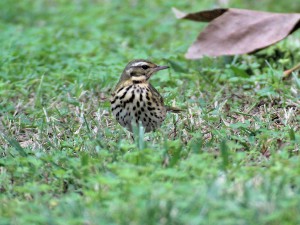Christmas arrived early in Orange County this weekend. Jeff Bray, a local birder, made the find of a lifetime: an Olive-backed Pipit (Anthus hodgsoni). Jeff found this bird at Yorba Regional Park. It may not sound like much, but it’s a really big deal.
Olive-backed Pipit – Previous Continental Records
For starters, there were only 3 previous records of this species in North America away from Alaska. (Here, we define North America geographically as including Mexico – not the birding definition). Washoe, Nevada hosted the first continental Olive-backed Pipit in 1967. Subsequent records came from Baja in 1996, and on the Farallon Islands in California in 1998. So the take-home message is, these guys don’t show up very often! Whenever a call like this goes out, birders do their version of a ‘flash mob’! The Yorba Regional Park mob on Saturday was very impressive!
I was among the first 20 birders there, but soon birders began arriving from all over the map in minutes. And soon it was a who’s who of southern California birders. And why not? This little Olive-backed Pipit really put on a show! It led us a merry dance at first, flying from place to place within the park. Frequently, it landed in heavy cover and skulked around. Sometimes the only visible indication it was there was movement of the vegetation it was walking under. But eventually, it came out on the lawn between the picnic tables and fed calmly for about an hour. Everyone there got crippling looks! In fact, the bird was remarkably cooperative, seeming oblivious to the camera shutter whir and quiet conversation of excited birders.
Olive-backed Pipit – Plumage Characteristics
The Olive-backed Pipit is a relatively small, slender bird, measuring about 6 inches from beak to tail. The back is a drab grayish olive green. A few darker feather centers form ill-defined solid or dotted lines down the back. Streaks mark the similarly colored crown. The primaries show more substantial dark inner edges. The outer primaries, when folded, show a hint of brighter olive green coloration. Very dark, well-defined spots and streaks mark the buffy upper chest and clean, bright white belly.
Olive-backed Pipit has a distinctive face pattern, with a bright supercilium that is yellow-tan across the base of the bill. Even more distinctive is the dark eyeline running right through the eye at the base of the bill. Crucial to the ID, it splits the white supercilium behind the eye. A tan “ear patch” with a distinctive brownish black patch at the rear borders more white on the lower cheek. A black malar stripe runs from below the bill to a black patch at the shoulder. The fairly deeply notched tail feathers were olive along the outer margins.
This particular Olive-backed Pipit had bright and long feather edging suggesting it had just completed a molt. Three of the black-centered median coverts had wide white fringes forming a bright upper wingbar. The tan, broadly-fringed greater coverts formed a less distinct lower wingbar. Basically, Olive-backed Pipit is a study in subtle beauty.
Olive-backed Pipit – Behavior
In behavior, the Olive-backed Pipit resembles an American Pipit (Anthus rubescens) in its foraging behavior. Except that it often prefers heavier cover. This bird “teetered” a lot (like a Spotted Sandpiper or an Ovenbird). It often bobbed and dipped its tail as it leaned forward to grab insects from the grass. It even teetered while walking on branches when flushed up into the trees by over-zealous birders or passing dogs. The bird rarely stood still at all during the entire time I watched it.
When in flight, it often gave a very high call with a burry tone to it. For a primarily a terrestrial bird, this Olive-backed Pipit often boldly flew very high in trees. It perched 75 feet up a sycamore at one point, and high in an oak later. But it always came back down sooner or later, much to the delight of the assembled crowd.
Olive-backed Pipit – Conservation Status
The IUCN (International Union for Conservation of Nature) designated Olive-backed Pipit a Red List species of least concern. Olive-backed Pipit thrives throughout Europe and Asia, without obvious signs of decline. However, no one is looking very closely at it. In the U.S., apart from the three other records, Olive-backed Pipit was heretofore found only on the islands off Alaska. It is casual on St. Lawrence Island and the Pribiloffs, and rare on the western Aleutians. Occasionally, larger fallouts of dozens of individuals occur when weather conditions are right. In any case, this Olive-backed Pipit was truly a special occurrence here, and a delight to watch.
Photos
The still photos in this post were digiscoped with a Swarovski ATX-95 spotting scope, a Swarovski TLS-APO digiscoping adapter and a DSLR camera.




